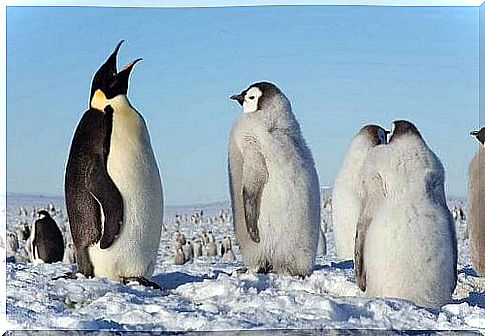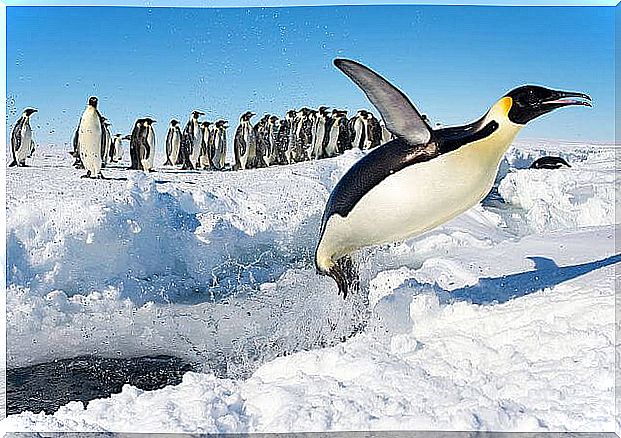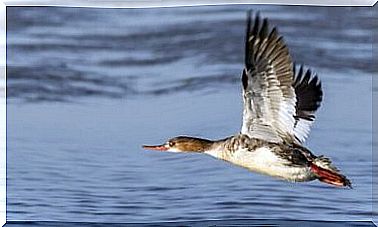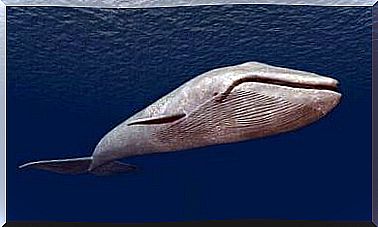The Hard Life Of The Emperor Penguin

The emperor penguin is a seabird no flier that belongs to the family Aptenodytes forsteri . It belongs to one of the 18 penguin species still existing and most of them are distributed in very cold areas. Like for example Antarctica and the Southern Ocean. What is most surprising, apart from its extraordinary resistance to cold, is the size of this animal, being the largest and heaviest of all penguins.
Adapted for living in Antarctica
The term “emperor” derives in fact from the size and weight of this formidable animal, capable of swimming underwater for over 18 minutes. Obviously, life at the South Pole is anything but simple, since you have to withstand extreme temperatures even below 50 degrees below zero in winter. Not surprisingly, Antarctica is considered one of the most inhospitable places on Earth. Fortunately, the emperor penguin was able to cope with the circumstances thanks to psychological adaptation techniques and surprisingly cooperative behavior.

This species forms large colonies and creates a community where it reproduces and has devised an efficient system for warming each other, based on turns. After forming a circle, the penguins keep close and, in rotation, those placed outside alternate in order to offer protection to everyone.
In this way, the penguins most exposed to the cold, on the outer row, can again find refuge in the center of the circle, where they warm up enough until they are ready to return to the front line again . To interact with each other, they use a series of vowel sounds that the scientific community is trying to study and decipher.
The great fatherly sense of the emperor penguin
The emperor penguin spends most of its life in the Antarctic ice and during the harsh winter it spends its days outdoors, a period in which reproduction occurs. The role of the female is limited to laying the egg: it is the father who hatches it.
As this happens, the mother begins a long and difficult journey to accumulate the food needed to support her family. It can travel up to 80 kilometers and, once in the open sea, hunts for fish, squid and krill . Once there, it can dive to a depth of 550 meters for a duration that, in some cases, can reach 20 minutes.
The penguin is a monogamous species and will have only one companion for life, to whom it will be loyal and from which it will obtain offspring. Oddly, the pair dynamics of this species position the female as a hunter. The male, on the other hand, will patiently wait out in the open taking care of the brooding. First by incubating its egg and then raising the chick.
For over two months, the male will go without food and will depend entirely on his partner returning home. The female will accumulate food in the stomach which will then regurgitate only in the throat of the chicks. It will be then that the male will return to the sea to look for food for himself.

The emperor penguin and climate change
At the beginning of 2017, thousands of specimens belonging to the Adelia penguin species ( Pygoscelis adeliae ) died en masse from causes related to global warming. These birds, located in East Antarctica, have the same feeding and breeding habits as the emperor penguin.
The journal Nature Climate Change published, by the way, a study that predicts a drastic reduction in the population of emperor penguins. By the turn of the century, two-thirds of the emperor’s species colonies will suffer a loss of more than 50%.
But what’s behind this catastrophic data? According to the Oceanographic Institution Woods Hello (WHOI), the survival of the emperor penguin and adelia depends on the thickness of the sea ice.
The climate models of the Intergovernmental Panel on Climate Change (IPCC), predict very sad data . Any change in ice, however slight, can be catastrophic: the thicker it is, the greater the distance women have to travel to get food. Otherwise, too thin a layer of ice can kill the krill habitat , one of the pillars in the penguin diet.
In short, in both cases there is a real risk that the tragedy of the Adélie penguins recurs and that thousands of cubs will die of hunger.
What do nations and NGOs think?
For this reason, the NGO World Wildlife Fund ( WWF) has called for the creation of a marine protected area in East Antarctica. The reason is to avoid a hypothetical opening of this area to krill fishing which would further reduce the food resources of the penguins.
Even though Australia and the European Union have been pushing the issue for eight years, there is still no protected area. Once again, changing temperatures threaten to end our planet’s rich biodiversity. It is necessary that institutions and citizens do everything possible to avoid a new tragedy. Unfortunately, the emperor penguin is about to become yet another innocent victim of selfishness and human ineptitude.
Photo authors: Fallschirmjäger, Hannes Grobe / AWI and Christopher Michel








